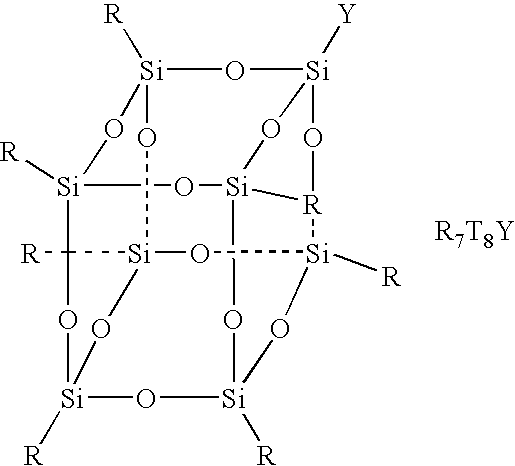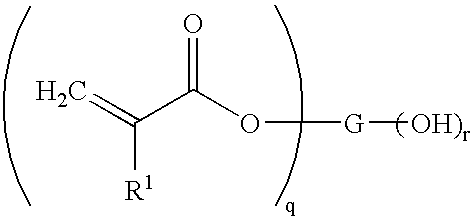Dental composite materials and method of manufacture thereof
a composite material and dental technology, applied in the field of composite materials, can solve the problems of high thermal expansion coefficient, poor performance of materials alone, and high cost of materials
- Summary
- Abstract
- Description
- Claims
- Application Information
AI Technical Summary
Benefits of technology
Problems solved by technology
Method used
Image
Examples
example 1
A resin matrix was prepared wherein 30 grams of EBPDMA, 50 grams of PUDMA and 20 grams of HDDMA were mixed in a beaker with a magnetic stirring bar. Photo-initiator (0.1 grams of camphorquinone, 0.3 grams of EDMAB and 0.2 grams of Lucirin™ TPO) was added into the resin mix and allowed to dissolve completely.
This photocurable resin composition was then used as a resin matrix and three more compositions were generated by adding (1) 30% wt POSS (methacryloxypropyl substituted polycyclopentyl T8 silsesquioxane from Gelest, Inc, available under the trade designation SST-H8C51); (2) 30 wt % silane treated OX-50 silica (Degussa Corp.) and (3) 20% T-530, a surface treated silica (Cabot, Inc.) (because of the high surface area of T-530, only 20 wt. % can be incorporated to obtain a workable composite). Three sample discs (1 mm thick, 15 mm diameter) were prepared for each composition and cured in a light chamber (Cure-Lite Plus, Jeneric / Pentron, Inc.) for two...
example 2
Polymerization Shrinkage
The following paste / putty-like composite formulations were prepared for the volume shrinkage measurements. Measurements were performed using a computer-controlled mercury dilatometer developed by the National Institutes of Science and Technology (NIST) / American Dental Association Health Foundation. The samples tested were as follows: Group 1: The basic resin composition as in Example 1 comprising 60 wt % of POSS particles; Group 2: The basic resin composition as in Example 1 comprising 60 wt % of silane treated OX-50; Group 3: The basic resin composition as in Example 1 comprising 15 wt % of the above POSS and 45 wt % silane treated OX-50; Group 4: The basic resin composition as in Example 1 comprising 15 wt % of the above POSS, 15 wt % silane treated OX-50 and 50 wt % of a silane surface treated barium borosilicate glass filler with average particle size of 0.7 micrometers. Group 5: The basic resin composition as in Example 1 comprising 0 wt % POSS, 1...
example 3
Polymerization Shrinkage Test
In this example, a dental resin comprising polymerizable ethylenically unsaturated methacrylates (FLOW-IT® ALC A2, from Pentron Corp.) was combined with silanated OX-50, a colloidal silica as the control sample, or with a combination of colloidal silica and methacryl isobutyl-POSS (MA0702, from Hybrid Plastics Corp.). The volume shrinkage on both samples was measured after curing.
TABLE 3VolumeComponentsWeight PercentShrinkage (%)FLOW-IT ® ALC A266.662.4POSS MA070216.65Silanated OX-5016.65FLOW-IT ® ALC A266.663.0Silanated OX-5033.33
The above results show that replacement of a portion of the colloidal silica with the POSS helps reduce the volume shrinkage upon curing.
PUM
| Property | Measurement | Unit |
|---|---|---|
| Shrinkage | aaaaa | aaaaa |
| Shrinkage | aaaaa | aaaaa |
| Shrinkage | aaaaa | aaaaa |
Abstract
Description
Claims
Application Information
 Login to View More
Login to View More - R&D
- Intellectual Property
- Life Sciences
- Materials
- Tech Scout
- Unparalleled Data Quality
- Higher Quality Content
- 60% Fewer Hallucinations
Browse by: Latest US Patents, China's latest patents, Technical Efficacy Thesaurus, Application Domain, Technology Topic, Popular Technical Reports.
© 2025 PatSnap. All rights reserved.Legal|Privacy policy|Modern Slavery Act Transparency Statement|Sitemap|About US| Contact US: help@patsnap.com



